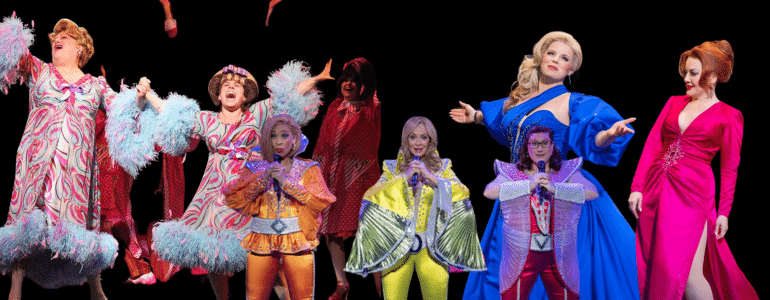10 Things I Learned From Edinburgh Fringe Festival
First, let me get this out of the way:
If you’re a theater fan who is interested in new works, you should go to the Fringe.
If you’re a theatermaker, who is interested in making new works, whether you’re a writer, producer, director, actor or anything . . . you must go to the Fringe.
For me, it was an inspirational experience.
To see the thousands of theatermakers creating new work, on small stages, in the most challenging circumstances, for little or no money . . . yet with such unbridled joy . . . was a reminder of why we all do what we do.
Broadway has been a challenge these past four years. And it’s not getting any easier. Since the pandemic, we’ve all questioned why we do it. We all questioned if we should do something else. We all developed a little bitterness as costs escalated, audiences haven’t returned in full . . . and making and marketing the work got harder.
For me? Being at the Fringe washed away that caked-on cynicism in one day. It was like going to a theater spa. I’m refreshed, renewed, and ready to double down on my commitment to making theater.
On top of THAT, I learned a Fringe-ton of stuff . . . about making theater, making theater at festivals, marketing theater, marketing theater at festivals, and also that Scotland makes a great food truck pizza (I had it twice in one day).
Here are 10 Things I Learned from the Edinburgh Fringe:
Outdoor Is Everywhere . . . and It Worked.
Look at these videos I took. Every wall, lamp post, and tunnel was filled with posters advertising the shows. And I gotta say, these outdoor ads are what got me thinking about what show to see more than anything (except one thing – see #2). Outdoor ads not only advertise your show, but the size and scope of it says your show is important.
Nothing Beats . . . Word Of Mouth
Despite all the outdoor ads, flyer folks, and other forms of advertising, how did we pick the shows we wanted to see? Just like on Broadway, word of mouth is what drives most of our ticket sales. We found ourselves asking EVERYONE, “What do you recommend? What did you love the most?” And when someone walked up to us cold with glitter on their face and said, “You must go see this show we just saw,” we bought tickets to House of Life moments later.
Short shows
90% of the shows we saw were 50 minutes to an hour. (This is partly due to the set-up-and-strike-before-the-next-production-in-the-same-location style of the Fringe that allows them to produce 3,000 shows..) This allowed us to see more shows. We never felt burned out. If something wasn’t our style, it was only 50 minutes to an hour.
But most importantly, and the biggest takeaway for all of us here and anywhere developing new works . . . if you’ve got a brand-new show, and you’re trying to get people’s attention or involvement for the future . . . maybe DON’T show them the whole thing! Do an abbreviated “Fringe” version. Show them only the best of what you got – because if this is the first time you’re presenting your show – it’s not opening-night ready yet – because you’ve never had an audience. So give ‘em an hour and get ‘em on the hook, giving you time to reel them in.
Hour-long readings or investor showcases here in the city should be the new norm in my book. (Unless you’re working your show creatively – in which case you gotta do the whole thing.)
The Immersive Movement Is Upon Us
We saw shows that didn’t have seats. We saw shows where the audience ended up on the stage. We saw shows where the audiences were encouraged to sing along. We saw shows where audience members made paper airplanes and flew them at other audience members.
In fact, we did NOT see ONE show that didn’t break the fourth wall at some point.
“What fourth wall?” is what current theatermakers are asking. And audiences are loving it.
So Much Can Be Done With So Little
One of my favorite podcast interviews was with Broadway and Hollywood A-list Director and Actor, Joe Mantello. He admitted that at one point in his career things on Broadway weren’t going as well as he would have liked. So, he went to Chicago and purposefully worked on small shows with no budgets . . . to jumpstart his creativity.
Working with limited time, means, space . . . forces the artistic genius in all of us to solve the problem with what we have. And THAT imagination is what the theater is all about.
We are not film. We are an imaginative art form. Embrace less and that can be more.
It worked for Joe. And all the Fringe shows we saw.
Mix & Mingle With Your Audience
After EVERY show, the creators, actors, etc. made a curtain speech. Of course they asked for online reviews and word-of-mouth recommendations to friends (see #2), but the majority of them also said they’d be outside after. “We’d love to have a drink with you,” was what I heard so many times. They took pictures, had pints, laughed, sold merch . . . and made connections with the people who matter most . . . the audience.
We should do the same . . . at readings and workshops, yes . . . and also at our shows.
Pandemic Time Was Productive Time.
A common phrase I heard from the theatermakers I met . . “We made this during the pandemic.” Not much to take away from this, except to say how inspired I was by all the folks out there who made stuff during a time when we weren’t sure if we were ever going to be able to do this again.
Those who used that time to be productive are reaping the rewards now. And if that wasn’t you? Well, it’s not too late. Start your thing today. The Fringe will start taking applications soon. 🙂
Same Time, Same Place, Same Festival.
A pain point about other festivals I’ve attended is the crazy performance schedules each show is given. “We’ve got 5 more shows! Today at 1:45, tomorrow at 11 AM, off for two days, then next Friday at 1 AM and Sunday and 4:37 PM.” Ugh.
All the shows we were pitched at the Edinburgh Fringe? “We’re here at 1 PM every day for the next two weeks except Monday.” Boom. It was so much easier for us to schedule our time and see more shows.
When scheduling your show for a festival or a run, keep things as consistent as possible. I like to think of my shows like “Must See TV”. Same time, same channel, every single week.
F&B Was Everywhere
It’s the UK, so the public consumption of a pint is more the rage than it is here in the States, but this might as well have been a foodie festival as well as an live arts festival. Every space had a variety of food, deserts, beverages and more. And let’s face it . . . everything’s better with F&B.
So Were Stars . . . But They Still Count.
Remember all those posters I talked about in #1? What adorned 90% of those posters were lots of four and five star reviews. The ads for shows were like a Van Gogh painting . . . it was so starry, starry. But they also worked.
Good housekeeping seals matter to audience members . . . especially when there is so much to choose from. And the stars work even if the sources are unknown. Get someone else . . . anyone or anything else (including audience members) to validate your work and it’ll help you stand out.
That’s 10 . . . but here’s a bonus . . . and it’s a big one . . .
People Effin’ Love Live Entertainment
I already talked about how inspiring it was to see those thousands of theatermakers joyfully doing what they love. But you know who else was loving everything fringey-minute of it? Every one of the hundreds upon hundreds of thousands of people who have descended upon Edinburgh every year. Almost 3 million tickets are sold!
What does that mean? What is the take away?
The fringe is about one thing . . . live entertainment. It’s not film. Or video games. (Although some shows can incorporate those elements for sure.) It’s LIVE. People have to show up to perform their art and people have to be there to see that art in order for it to BE art.
And boy do they show up.
So for those of you who doubt that the theater will continue to thrive . . . go to the Fringe. It’s the greatest reminder that people gathering to hear great stories told in interesting ways is the oldest form of entertainment . . . and IMHO, the absolute greatest.
See you next year.
And special thanks to the inaugural year of Playbill’s Fringe Ship for taking such great care of me, and my producers, investors and more who went as a group! We’re already making plans to travel together again. If you’d like to hear about our next theatermakin’ trip, sign up for my newsletter here so you can be the first to know what we’ve got cookin’. Announcement coming in October.
– – – – –
Got a comment on this article? I want to hear it! I write these articles because I believe the world is a better place if there is more theater in it. And there is only more theater in the world if we’re talking about how to make more theater and better there.
And your comment will help!
Click here to comment on Facebook. Click here to comment on Instagram. Click here to comment on LinkedIn.Podcasting
Ken created one of the first Broadway podcasts, recording over 250 episodes over 7 years. It features interviews with A-listers in the theater about how they “made it”, including 2 Pulitzer Prize Winners, 7 Academy Award Winners and 76 Tony Award winners. Notable guests include Pasek & Paul, Kenny Leon, Lynn Ahrens and more.














